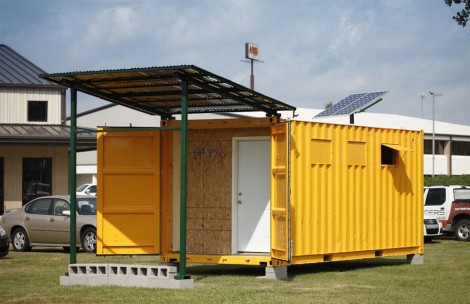Why Aren’t More Homes Hurricane Proof?
In a severe hurricane there are two types of homes—the kind you flee and the hurricane-proof kind that safely host awesome hurricane parties. Given the frequency of these destructive storms, it’s strange there aren’t more homes built to withstand hurricanes. However, some architects and designers are hard at work dreaming up possible homes that could withstand a category five weather nightmare. Many of the designs are futuristic in concept, but there are some practical designs out there as well.
To survive the foes of wind and wave a home must be able to withstand wind speeds of 75-150+ miles per hour, as well as flooding or storm surges that can reach from 4-18 feet or more. On top of that, bonus points are awarded for roofs that can withstand falling trees and windows that deflect flying debris, like the trashcans the lazy neighbor left out. In the face of such elements, it isn’t surprising that plastic siding and single-pane windows reinforced with tape don’t stand up to the shear power of a hurricane.
Popular hurricane-proof designs tend to feature building materials like metal and concrete, elevated living areas and dome-like shapes. An ancient architectural form, Domes are utilized in everything from igloos to the Sistine Chapel because of their inherent strength and ability to repel the full force of wind.
Various architects have experimented with dome shapes, including the legendary Buckminster Fuller and his geodesic domes. His Dymaxion House in the image below was designed to stand up to tornadoes as well as wind gusts of up to 150 miles per hour. Not bad for an inexpensive structure that looks like an orange juicer and was designed to be a mobile home.
One of the most famous houses to withstand a hurricane was the Dome Home, which survived Hurricane Ivan and its tremendous storm surge. While the neighboring houses were either completely destroyed or simply trashed, owner Mark Sigler safely housed a news crew in his self-designed house (image below) and rode the storm out in comfort.
Built to withstand winds up to 300 miles per hour, the home sustained little damage, partly because of its thick walls and dome shape, but also because it was designed to allow water to pass under the house. The living quarters are 22 feet above the ground.
Given the danger from tidal and storm surges, elevated homes are ideal for reducing the risk of flooding. This design allows limits the risk of water from entering the home, or from being battered by the waves and debris. There are additional costs for this and it’s another staircase to climb, but its a better alternative to having a shark swimming through your front door.
Because so much hurricane dammage occurs in poor parts of the Caribbean and Central America, there are increased efforts to create inexpensive, hurricane-proof housing. Following the tragic earthquake in Haiti in 2010, relief agencies have increasingly turned to using metal shipping containers for alternate housing.
There are probably issues with how the metal heats up in the sun, but there’s no arguing with the how they come through heavy winds unscathed. Researchers studying the rainforest in Australia actually withstood a category 5 cyclone in the shipping container home below.
With the billions of dollars in property destroyed each year by hurricanes one would think more would be done to improve designs, yet homes tend to possess little more than hurricane shutters. Thus, when you search for “Hurricane-proof homes” you find far less material than if you search for “go-bags” or “hurricane evacuation routes.” The internet is filled with instructions for attaching plywood over windows and sandbagging around the house, but these are little more than these bandaid fixes.
Given the recurring pattern of destruction and rebuilding in hurricane prone areas, many architects and planners are trying to completely rethink how humans fit into these environments. The gigantic trigone below was designed as an alternative living situation for 40,000 people in New Orleans. It’s a bold new look that will probably never be built, but there’s definitely logic in its design.
Other articles by Estately…
Hey, There’s A Pet In My Listing Photo













